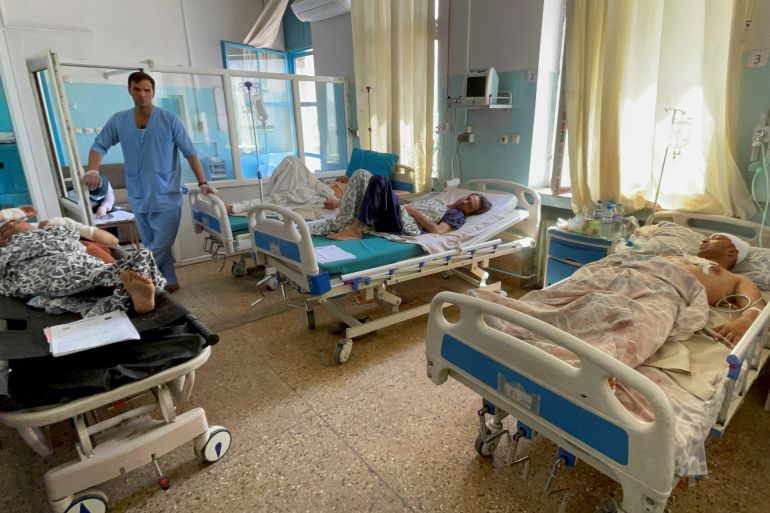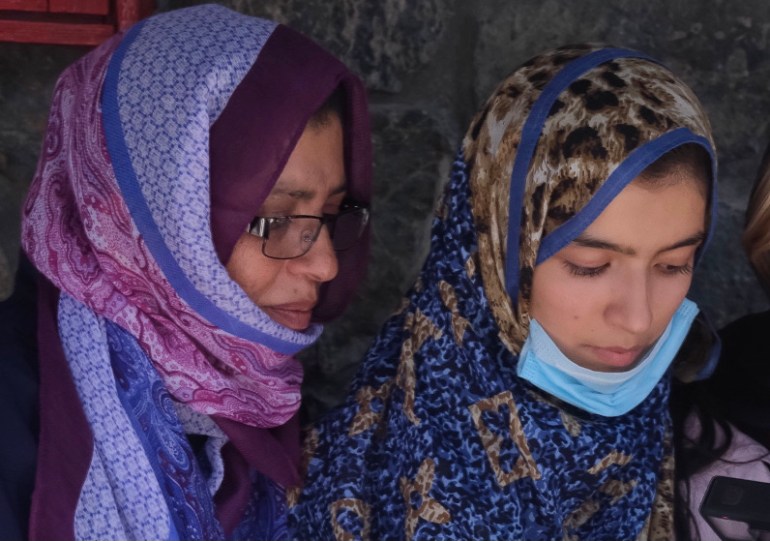Families of Kabul airport bombing victims scramble for news
Bombing claimed by ISIL affiliate around Kabul’s airport killed at least 175 people and wounded more than 100 others.

Kabul, Afghanistan – Families of the victims of the bombings outside Kabul airport that killed at least 175 people and injured about 120 others are clamouring for news of their loved ones.
Dozens of families crowded outside Kabul’s Emergency Hospital on Friday. One among them – Muzda Nikanjam, 17, alongside her mother Zarghuna – was desperate to know about her father Abdol Naser, who has been undergoing treatment for more than 15 hours at the hospital.
Keep reading
list of 4 items‘Vicious attack’: World leaders condemn Kabul suicide blasts
Taliban planning ‘inclusive caretaker gov’t’ in Afghanistan
Hundreds of displaced Afghan families seeking food and shelter
At the urging of his former colleagues in the Afghan intelligence services, on Thursday Abdol Naser joined thousands of others at the airport hoping to flee the Taliban’s takeover of Afghanistan.
He had been outside the airport for about six hours when a bomb blast – claimed by the Islamic State in Khorasan Province, ISKP (ISIS-K) – struck just after 6:30pm (14:00 GMT).
“My husband went to the airport with his intelligence ID, hoping to get out,” Zarghuna, Muzda’s mother, said.
Prior to arriving at the airport on Thursday, Naser had not stepped out of the house for 12 days, fearing the Taliban would recognise him as having worked in the intelligence services. His plan was to escape from Afghanistan, then send for his family.
Soon after the first explosion, Zarghuna received a phone call saying her husband was injured, as Abdol Naser’s friends desperately tried to get him to hospital among thousands of people, hundreds of cars and kilometres of unpaved roads. With the roads blocked, Naser had to be transported to the main road by cart.

When Zarghuna and Muzda arrived outside the hospital, they were met with a cluster of people, each trying to find out what had befallen their family.
“They didn’t give us permission to see him and his abdomen and hands were hurt,” Zarghuna said. “We’ve only seen pictures of him and he was bloody.”
All they know is he is in the intensive care unit and needs further treatment – he will likely remain in the hospital for several more days.
Staff at the Emergency Hospital say that at least 100 wounded people have been brought to the facility since the Thursday evening bombing, most with severe injuries.
At least 175 people died in the attack, Taliban sources told Al Jazeera.
With thousands of people crowded outside the Kabul airport when the bombs went off, the numbers of the dead and wounded are likely to rise.
Since the Taliban seized control of the country on August 15 as foreign forces withdraw, many Afghans have attempted to flee over fears that the group may reprise its brutal rule between 1996-2001 during which women’s freedoms and human rights were severely curtailed.
There are also concerns that an economic collapse is imminent as foreign institutions and countries withhold aid and funds after the Taliban takeover.
The desperation to flee is also growing as the US and foreign allies race to complete evacuations before the August 31 deadline to withdraw from Afghanistan imposed by President Joe Biden.
‘Madness’
Zainab Hossaini, who was with her husband when he was injured in the bombing on Thursday, described the immediate aftermath of the blast as “madness”.
Hossaini had spent hours with 13 other family members sitting by a concrete blast wall near a stream of sewage. She had to throw herself and her children into the filthy green-brown water to escape.
“People were literally climbing over one another. No one was looking at what was around them, they were all just trying to escape,” she said.
Hossaini says her sister was injured when she was trampled by people fleeing the scene.
Finding a car to transport her husband, whose legs were badly wounded, proved impossible.
They threw him on a cart that had been selling food only minutes earlier and careened through the hundreds of cars and crowds of thousands of people until they reached the main street, more than 1km (0.6 miles) away. It took them more than an hour to reach the Emergency Hospital.
Like the Nikanjams, Hossaini has little information on her husband’s exact condition. All she knows is that his legs are badly damaged and he will have trouble walking again.
Hossaini’s husband was also part of the Afghan National Security Forces, and though the Taliban claims to have given a blanket amnesty to former security forces and government officials, the family did not trust the assurances and decided to try to escape the country before the August 31 deadline.
Despite the gruesome scenes they witnessed and the painful injuries their husbands suffered, the Nikanjam and Hossaini families were luckier than others outside the hospital.
Jawed, 17, spent much of Friday morning going from one hospital to another trying to find his older sister, Narges. Their family was sitting not far from the Hossaini family when the bomb went off.
Narges lost contact with her family amid the chaos and fleeing crowds following the explosion, and by Friday morning, her family had uploaded a missing person’s flyer to social media.
“We’ve been everywhere, we just hope she’s still alive,” Jawed said as he prepared to head to yet another medical facility to look for Narges.
Gholam Hassan is waiting for word on his injured 17-year-old nephew being treated in the hospital. His nephew was encouraged by his friends to go to the airport and try their luck before the withdrawal deadline.
“Let’s just try before time runs out,” they told the teenager late on Thursday morning.
Hassan and other middle-aged men sitting on the benches outside the hospital said they saw at least 15 bodies being transported out of the hospital early on Friday.
“You wouldn’t believe the state people were in. There were bodies with no arms and legs, others with no heads,” Hassan said.
‘He wanted a better future’
The people waiting outside the hospital also have their own security fears. At 11pm on Thursday, a blast from an unknown nearby location triggered panic.
The Taliban, which had been posted outside the hospital, began shooting into the air to disperse the crowds, just as they and Afghan CIA-backed intelligence forces had been doing for more than a week outside the airport.
Afghanistan is braced for more attacks as the desperation builds in the run-up to the evacuation deadline. The roads leading to the airport are largely inaccessible with the Taliban having increased security and expanding the perimeter of the area they control by at least 500 metres (547 yards).
The Pentagon said on Friday the attack at the airport was carried out by one suicide bomber, not two as earlier thought, and that there were “credible threats” of further attacks by ISKP.
The US, which lost 13 personnel during the Thursday attacks, at present has 5,800 soldiers at the airport in Kabul working to evacuate thousands of US citizens, Afghans and others. According to the White House, the US and its allies have evacuated at least 105,000 people since August 14, one day prior to the Taliban’s arrival in the Afghan capital. Evacuations resumed on Friday.
Meanwhile, funerals were held on Friday for the victims of the bombing.
At the Wazir Akbar Khan hill, where a huge Afghan flag flew before the Taliban takeover of the city, dozens of mourners gathered.
Taj Mohammad visited the cemetery to bury his cousin Sekandar, who was also part of the security forces. He said his cousin, who was like a brother to him, was hoping to get to the US and then send for his wife and four children, who were at home at the time of the attacks.
Like so many others who perished in the blasts, Mohammad says his cousin was simply looking for a life away from the bombings, raids and allegations of revenge killings that have come to plague the country over the last 20 years.
“He wanted a better future for his family,” Mohammad said. “But he died for it.”